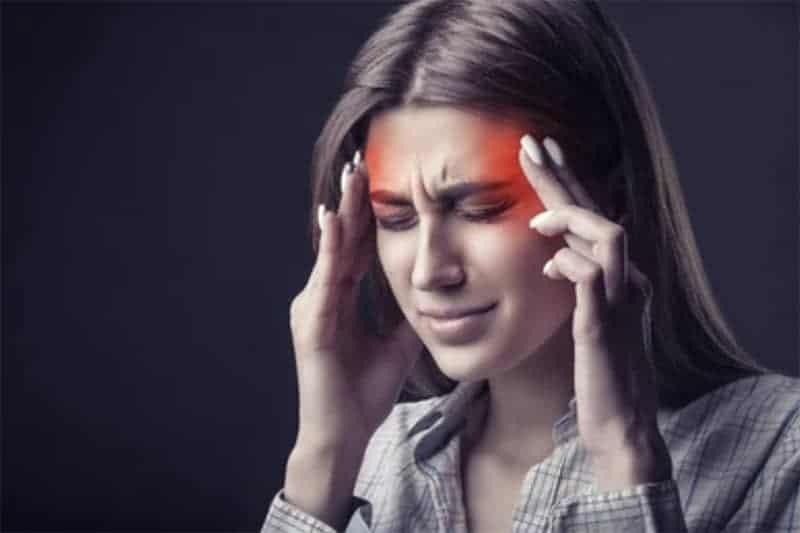Migraine is a neurological condition causing multiple signs and symptoms. It affects 20% of women and 6% of men at some point in their lives. Its causes remain largely unknown. Migraine is frequently characterised by severe, debilitating headaches that are usually on one side of the head. Migraines often run in families and can affect all ages.
Causes
Healthcare professionals don’t know the exact cause of migraine headaches, although migraine seems to be related to changes in your brain and your genes. For many years, researchers thought migraines occurred because of changes in blood flow in the brain. Now. Most researchers believe this can contribute to the pain, but it is not what starts it.
Current thinking is that a migraine likely starts when hyperactive nerve cells send out signals that trigger your trigeminal nerve. The trigeminal nerve is the nerve giving sensation to your head and face. Activating this nerve leads your body to release chemicals like serotonin and calcitonin gene-related peptide (CGRP). CGRP causes the swelling of blood vessels in the lining of your brain. Consequently., inflammation and pain start appearing.
Risk factors and triggers
- There are many risk factors and triggers that increase the chances of developing migraines. The following among them are particularly associated with migraine:
- Sex: Females have migraines three times more often than men.
- Age: Most people start experiencing migraines between ages 10 and 40. But many women report that their migraines get better after age 50.
- Family history: Four out of five åeople have a family history of margarine, suggesting a genetic predisposition.
- Hormonal influences: Conditions causing Hormonal changes can also exacerbate it. For example, pregnancy, periods, ovulation, menopause, birth control, etc., are tied with migraine symptoms.
- Medications: such as oral contraceptives and vasodilators.
- Sensory stimulation: Loud noises, bright lights, and strong smells can start a migraine episode.
- Foods: Certain foods such as cheese, alcohol, additives, and salty and processed foods can trigger migraines.
- Stress: Stress causes your brain to release chemicals that can cause blood vessel changes that can lead to a migraine.
- Weather: Weather changes such as storm fronts, changes in barometric pressure, strong winds, or changes in altitude can all potentially trigger a migraine.
- Sleeping too much or not getting enough sleep can also trigger migraines.
- Medical conditions: Depression, anxiety, bipolar disorder, sleep disorders, and epilepsy can increase your risk of developing migraines.
Types of Migraine
There are several types of migraines. The most common among them are migraine with aura (called classic migraine) and migraine without aura (or common migraine). Other types include:
- Menstrual migraine
- Vestibular migraine
- Abdominal migraine
- Hemiplegic migraine
- Ophthalmic migraine
- Status migrainosus
- Ophthalmoplegic migraine
Signs and Symptoms
Signs and symptoms of migraine can be divided into those appearing before the attack and those that constitute the attack. The symptoms that occur before the migraine are known as prodromal symptoms.
Prodromal symptoms are:
- Constipation
- Mood changes
- Swift Food cravings
- Neck rigidity
- Increased urination
- Excessive thirst
- Yawning
- Frequent yawning
Symptoms of migraine aura include:
- Visual hallucinations
- Flash Of light in front of eyes
- Temporary loss of vision
- Pin and limb sensation in their limbs.
- Abnormal body moves
- Difficulty in speaking
In around 20% of patients, migraine begins with aura (previously called ‘classical’ migraine). Shimmering, silvery zigzag lines (fortification spectra) start appearing across the visual fields for up to 40 mins, sometimes. This can sometimes cause temporary blindness. Another 80% of patients suffer from migraines without aura. Following are the characteristics of a migraine attack:
- Severe and throbbing pain
- Photophobia
- Irritation to noise or even voice
- Vomiting
- Pain exacerbated by movement
- Limbs weakness
Diagnosis
Doctors, particularly experts in headaches (neurologists), can diagnose migraines based on your history, clinical features, and general physical and neurological examination. So, the diagnosis of migraine is mainly clinical. Yet, your doctor may advise the following tests to rule out any other disease:
- Blood Tests: They can help you identify fever and other inflammatory conditions that may be causing your headache.
- MRI. It can help a doctor diagnose any tumour, stroke, bleeding in the brain, infections, and other problems.
- CT scan: A series of X-rays created through a CT scan creates a detailed image of the brain.
Management
Your doctor can recommend any of the following treatment options to resolve the acute attack of migraine:
- Simple analgesia with over-the-counter (OTC) painkillers
- Antiemetic medications to stop the vomiting if there is any
- Triptans such as sumatriptan are used to treat the severe attacks of migraine.
Newer modalities and other treatment options for migraine are:
- Acupuncture.
- Biofeedback.
- Cognitive behavioural therapy (CBT)
- Herbs, vitamins and minerals.
- A high dose of riboflavin (vitamin B-2)
Prevention
Lifestyle changes and medications can help you minimise the risk of developing severe migraine attacks. These strategies are:
- Avoidance of identified triggers or exacerbating factors
- Keeping track of your signs and symptoms and their patterns
- Adopting stress coping techniques such as meditation, yoga and mindfulness
- Consuming plenty of fluids
- Sleeping and waking up at a regular time
- Regular physical activity, no matter how mild it can be
If these lifestyle changes are ineffective in helping you, you can ask your doctor to prescribe you some preventive medications. Some of the most commonly used medicines for the prevention of migraine are:
- Calcium channel blockers such as verapamil
- Beta-blockers such as propranolol
- Antidepressants, particularly tricyclic antidepressants (amitriptyline) can prevent migraines.
- Anti-seizure drugs such as Valproate and topiramate
- Botox injections about every three months offer protection against migraines in some adults.
- New drugs such as calcitonin gene-related peptide (CGRP) monoclonal antibodies
Some new devices have been developed to prevent migraines. For example, Cefaly is a headband-like gadget that affects your trigeminal nerve, linked with migraine headaches. Affecting this nerve increases the chance of preventing migraines. You can wear Cefaly once a day for 15-20 minutes. When it’s on, it gives a tingling or massaging sensation. Another device, gammaCore, sends out a mild electrical signal to the vagus nerve in your neck. This signal can help prevent migraines.
The Takeaway Message
Adopt a healthy lifestyle to avoid developing migraine headaches. In addition, there are many medicines that can prevent as well as resolve an acute attack of migraine. If you’re suffering a migraine headache that is not getting relieved by over-the-counter (OTC) medications, it would be the best idea to consult your doctor. He can assess your signs and symptoms, examine you, run some tests, and formulate an effective personalised treatment plan for your migraine.








